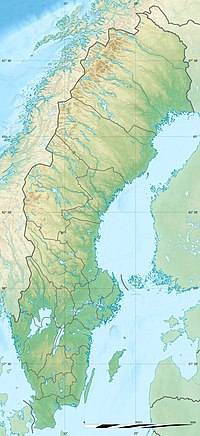Kebnekaise
- See Kebnekajse for the Swedish band.
| Kebnekaise | |
|---|---|
 Kebnekaise, view from Tuolpagorni | |
| Highest point | |
| Elevation | 2,106 m (6,909 ft)[1] |
| Prominence | 1,750 m (5,740 ft)[2] |
| Listing | Country high point Ultra |
| Geography | |
| Region | SE |
| Parent range | Scandinavian Mountains |
| Climbing | |
| First ascent | 1883 by Charles Rabot |
| Easiest route | rock/ice walk |
Kebnekaise (from Sami Giebmegáisi or Giebnegáisi, "Cauldron Crest") is the highest mountain in Sweden. The Kebnekaise massif, which is part of the Scandinavian Mountains, has two peaks, of which the southern, glaciated one is highest at 2,106 metres (6,909 ft) above sea level at the latest time of measurement. The north top (2,097 metres (6,880 ft)) is free of ice. Kebnekaise lies in Lapland, about 150 kilometres (ca. 90 miles) north of the Arctic Circle and west of Kiruna near the popular Kungsleden hiking trail between Abisko and Nikkaluokta.
The glacier has shrunk, and therefore the summit is not as high as earlier. The top is traditionally said to be 2,111 metres (6,926 ft), and higher in the oldest measurement, i.e. 2,117 metres (6,946 ft). If the melting continues at the same rate, the south peak will sink below the north peak (which is the highest fixed point in Sweden) within a few years' time.[3][4]
A mountain lodge, Kebnekaise mountain lodge (Kebnekaise fjällstation), is located at the foot of Kebnekaise, ca. 19 km, 6–7 hours from Nikkaluokta. It is the starting point for an ascent via the western route (västra leden, ca. 13 km, 4–6 hours to the summit) or the eastern route (östra leden, ca. 10 km, 3–5 hours to the summit). The western route leads over scree slopes and the intermediate peak Vierranvárri to the glaciated summit. Most of this route to the top is pure hiking, but there is a short exposed part that could possibly count as scrambling. The eastern route, however, leads over glaciers and rocks (UIAA grade I-II) and is equipped with fixed steel cables similar to a via ferrata.

August 2007
There is also a third, less popular route only marked with cairns - Dürling's route, which branches off Kungsleden a few kilometers north of Singi, goes about two kilometers into the southern side of Singivagge, and then turns north into the valley between Kuopertjåkka and the unnamed peak west of Vierranvárri. One should keep on the eastern side of the stream running down this valley until the route merges with the western route. Some people, such as those with acrophobia or wanting to summit with heavy backpacks, may see benefits with this route as not really a single point is exposed; however, passing through very rough scree and rock terrain is required especially in the slopes leading up to the valley between Vierránvarri and Kebnekaise (Kaffedalen).
In mainland Europe, there are no higher mountains further north[citation needed] (there is, however, a higher point at Beerenberg on the island of Jan Mayen). It is said that an area (of both Sweden and Norway) corresponding to 9% of Sweden's surface area can be seen from the summit, which approximates to more than 40,000 km² – almost the size of the Netherlands.
In March 2012 a Norwegian military transport aircraft crashed into the western wall killing all five onboard.
References
- ^ "Statistisk årsbok 2011" (in Swedish). Statistics Sweden. p. 10. Archived from the original (PDF) on 5 July 2011. Retrieved 10 July 2011.
- ^ Mountains I have climbed and remember
- ^ Malin Olofsson, "Toppskifte på Kebnekaise", Sveriges Radio, 15 June 2007, retrieved 27 March 2012 Template:Sv icon
- ^ Kebnekaises sydtopp – högst i Sverige?, fjallklubben.org (broken link)
External links
- Photo gallery on Marco Klüber Photography
- Ski touring reports from Swedish mountains, including Kebnekaise (English)



